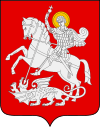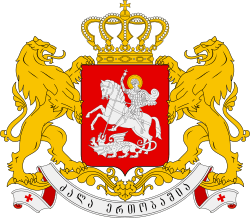Kingdom of Abkhazia
The Kingdom of Abkhazia (Georgian: აფხაზთა სამეფო), also known as Abasgia or Egrisi-Abkhazia, was a medieval Georgian feudal state in the Caucasus which lasted from the 780s until being united, through dynastic succession, with Kingdom of the Iberians, which resulted in formation of unified the Kingdom of Georgia in 1008. In the early years of the 10th century, Kingdom of Abkhazia stretched, according to Byzantine sources, along the Black Sea coast three hundred Greek miles, from the frontiers of the thema of Chaldia to the mouth of the river Nicopsis, with the Caucasus behind it.
Kingdom of Abkhazia აფხაზთა სამეფო apkhazta samepo | |||||||||||
|---|---|---|---|---|---|---|---|---|---|---|---|
| 778–1008 | |||||||||||
.png) The Kingdom of Abkhazia from 850–950, at the peak of its territorial expansion.
Kingdom of Abkhazia
Tributaries and sphere of influences
| |||||||||||
| Capital | Anacopia (778-786) Kutaisi (786-1008) | ||||||||||
| Common languages | Georgian Greek (religious)[upper-alpha 1] | ||||||||||
| Religion | Eastern Orthodox (Georgian Orthodox Church) | ||||||||||
| Government |
| ||||||||||
| archon | |||||||||||
• c. 510–530 | Anos (first) | ||||||||||
• c. 745–767 | Leon I (last) | ||||||||||
| King | |||||||||||
• 767–811 | Leon II (first) | ||||||||||
• 978–1014 | Bagrat III (last) | ||||||||||
| Historical era | Early Middle Ages | ||||||||||
• Declared independence from Byzantine | 778 | ||||||||||
• Unification of the Georgian State | 1008 | ||||||||||
| Currency | Various Byzantine and Arab coins[2] | ||||||||||
| |||||||||||
| Today part of | |||||||||||
| History of Georgia |
|---|
 |
|
Middle Ages
|
|
Early modern history |
|
Modern history |
|
History by topic |
|
|
History
Background
.jpg)
Abkhazia, or Abasgia of classic sources, was a princedom under Byzantine authority. It lay chiefly along the Black Sea coast in what is now the northwestern part of the modern-day Georgia (disputed Republic of Abkhazia) and extended northward into the territory of today's Krasnodar Krai of Russia. It had Anacopia as the capital. Abkhazia was ruled by a hereditary archon who effectively functioned as a Byzantine viceroy. The country was chiefly Christian and the city of Pityus was a seat of an archbishop directly subordinated to the Patriarch of Constantinople. Another Abasgian episcopal see was that of Soteropolis.[3]
In 735, a large expedition led by Arab general Marwan was launched against the Georgian kingdoms. The Arabs, pursuing the retreating Georgian princes – brothers Mirian and Archil – surged into Abkhazia in 736. Dysentery and floods, combined with a stubborn resistance offered by the archon Leon I and his Iberian and Lazic allies, made the invaders retreat. Leon I then married Mirian's daughter, and a successor, Leon II exploited this dynastic union to acquire Lazica in the 770s. Presumably considered as a successor state of Lazica (Egrisi, in Georgian sources), this new polity continued to be referred to as Egrisi (Lazica) in some contemporary Georgian (e.g., The Vitae of the Georgian Kings by Leonti Mroveli) and Armenian (e.g., The History of Armenia by Hovannes Draskhanakertsi) chronicles.
Establishment and consolidation
The successful defense against the Arabs, and new territorial gains, gave the Abkhazian princes enough power to claim more autonomy from the Byzantine Empire. Towards circa 778, Leon II won his full independence with the help of the Khazars; he assumed the title of "King of the Abkhazians" and transferred his capital to the western Georgian city of Kutaisi. According to Georgian annals, Leon subdivided his kingdom into eight duchies: Abkhazia proper, Tskhumi, Bedia, Guria, Racha and Takveri, Svaneti, Argveti, and Kutatisi.[4] During his reign Abkhazian kingdom was at the stage of the state building and was less active in the matter of spreading the borders of the kingdom to the East. After obtaining of the state independence, the matter of the church independence became the main problem. In the early 9th century Abkhazian Church broke away from Constantinople and recognized the authority of the Catholicate of Mtskheta; language of the church in Abkhazia shifted from Greek to Georgian, as Byzantine power decreased and doctrinal differences disappeared.[5]
The most prosperous period of the Abkhazian kingdom was between 850 and 950. Beginning with George I (c.864 – 871), the increasingly expansionist tendencies of the kingdom led to the enlargement of its realm to the east. The Abkhazian kings controlled duchy of Kartli (central and part of eastern Georgia), and interfered in the affairs of the Armenian and Georgian Bagratids. In about 908 King Constantine III (c.894 – 923) had finally annexed a significant portion of Kartli, bringing his borders close to the Arab-controlled Tbilisi. For a brief period of time, Kakheti and Hereti in eastern Georgia also recognized the Abkhazian suzerainty. Constantine III also tried to extend his influence over Alania by supporting their Christianization. Under his son, George II (c.923 – 957), the Abkhazian Kingdom reached a climax of power and prestige. George was also known as a promoter of Orthodox Christianity and a patron of Georgian Christian culture. He helped to establish Christianity as an official religion in Alania, winning the thanks of Constantinople. The contemporary Georgian annals knew him as a "builder of churches". George's successors, however, were unable to retain the kingdom's strength and integrity. During the reign of Leon III (c.960–969), Kakheti and Hereti emancipated themselves from the Abkhazian rule. A bitter civil war and feudal revolts which began under Demetrius III (c.969–976) led the kingdom into complete anarchy under the unfortunate Theodosius III the Blind (c.975 – 978), a weak and inauspicious king.
Unification
.jpg)
By that time the hegemony in Transcaucasia had finally passed to the Georgian Bagratids of Tao-Klarjeti. In 978, the Bagratid prince Bagrat, nephew (sister's son) of the heirless Theodosius, occupied the Abkhazian throne with the help of his adoptive father David III of Tao. Bagrat's descent from both Bagratid and Abkhazian dynasties made him an acceptable choice for the nobles of the realm who were growing weary of internecine quarrels. In 1008, Bagrat succeeded on the death of his natural father Gurgen as the "King of the Iberians". Thus, these two kingdoms unified through dynastic succession, in practice laying the foundation for the unified Georgian monarchy, officially styled then as the Kingdom of Georgia.
Rulers
Most Abkhazian kings, with the exception of John and Adarnase of the Shavliani (presumably of Svan origin), came from the dynasty which is sometimes known in modern history writing as the Leonids after the first king Leon, or Anosids, after the prince Anos from whom the royal family claimed their origin. Prince Cyril Toumanoff relates the name of Anos to the later Abkhaz noble family of Anchabadze.[6] By convention, the regnal numbers of the Abkhazian kings continue from those of the archons of Abasgia. There is also some lack of consistency about the dates of their reigns. The chronology below is given as per Toumanoff.
| King | Reign | dynasty |
|---|---|---|
| 1. Leon II | 780 – 828 | Anchabadze |
| 2. Theodosius II | 828 – 855 | Anchabadze |
| 3. Demetrius II | 855 – 864 | Anchabadze |
| 4. George I | 864 – 871 | Anchabadze |
| 5. John (usurper) | 871 – 873 | Shavliani |
| 6. Adarnase | 887 – 893 | Shavliani |
| 8. Bagrat I | 882 – 894 | Anchabadze |
| 9. Constantine III | 894 – 923 | Anchabadze |
| 10. George II | 923 – 957 | Anchabadze |
| 11. Leon III | 957 – 967 | Anchabadze |
| 12. Demetrius III | 967 – 975 | Anchabadze |
| 13. Theodosius III | 975 – 978 | Anchabadze |
| 14. Bagrat II | 978 – 1008 | Bagrationi |
Historiographical conundrum
Writing the kingdom's primary history was dominated by Georgian and Byzantine sources supported by modern epigraphic and archaeological records.
The problem of the Abkhazian Kingdom, particularly the questions of the nature of its ruling family and its ethnic composition, is a major point of controversy between modern Georgian and Abkhaz scholars. This can be largely explained by the scarcity of primary sources on these issues. Most Abkhaz historians claim the kingdom was formed as a result of the consolidation of the early Abkhaz tribes that enabled them to extend their dominance over the neighboring areas. This is objected to on the side of the Georgian historians, some of them claiming that the kingdom was completely Georgian.
Most international scholars agree that it is extremely difficult to judge the ethnic identity of the various population segments[7] due primarily to the fact that the terms "Abkhazia" and "Abkhazians" were used in a broad sense during this period—and for some while later—and covered, for all practical purposes, all the population of the kingdom, comprising both the Georgian (including also Mingrelians, Laz, and Svans with their distinct languages that are sisters to Georgian) and possible modern Abkhaz (Abasgoi, Apsilae, and Zygii) peoples.[8] It seems likely that a significant (if not predominant) proportion of the Georgian-speaking population, combined with a drive of the Abkhazian kings to throw off the Byzantine political and cultural dominance, resulted in Georgian replacing Greek as the language of literacy and culture.[9]
Legacy
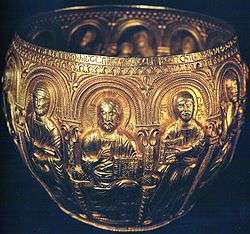 The Bedia Chalice donated by Bagrat to the Bedia Monastery is an important piece of Georgian metal art. c. 999 AD
The Bedia Chalice donated by Bagrat to the Bedia Monastery is an important piece of Georgian metal art. c. 999 AD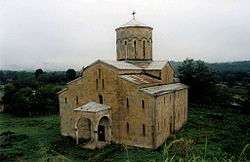 Mokvi Cathedral constructed in 10th century, during the reign of King Leon III of Abkhazia
Mokvi Cathedral constructed in 10th century, during the reign of King Leon III of Abkhazia.jpg) Church of St. Simon the Canaanite constructed between 9-10th century in New Athos
Church of St. Simon the Canaanite constructed between 9-10th century in New Athos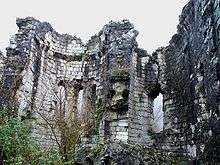 Church of Bzyb constructed in the second half of IX century
Church of Bzyb constructed in the second half of IX century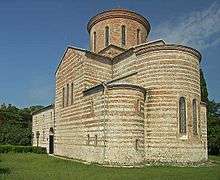 Pitsunda Cathedral was built at the end of the 10th century by King Bagrat III of Georgia.
Pitsunda Cathedral was built at the end of the 10th century by King Bagrat III of Georgia.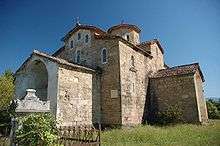 Lykhny Church built in the 10th century.
Lykhny Church built in the 10th century..jpg) Chkondidi cathedral built by George II, X century
Chkondidi cathedral built by George II, X century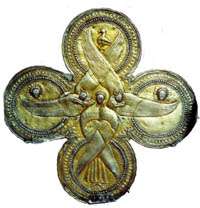 The cross of George II of Abkhazia, X century
The cross of George II of Abkhazia, X century.jpg) The remains of the Bagrat's Castle.
The remains of the Bagrat's Castle. Kumurdo Cathedral was built by Ioane the Bishop during the reign of King Leon III of Abkhazia in 964.
Kumurdo Cathedral was built by Ioane the Bishop during the reign of King Leon III of Abkhazia in 964.
See also
Notes
- "It was also during the tenth century that the language of the church in Abkhazia shifted from Greek to Georgian (Inal-Ipa, 1965, p570)."[1]
References
- Hewitt 2013, p. 63.
- Rayfield, Donald (2012). Edge of Empires: A History of Georgia. London: Reaktion Books. p. 63. ISBN 1780230303.
- Annuario Pontificio 2013 (Libreria Editrice Vaticana, 2013, ISBN 978-88-209-9070-1), p. 975
- Vakhushti Bagrationi, The History of Egrisi, Abkhazeti or Imereti, part 1.
- Rapp 2007, p. 145
- Rapp, pages 481-484.
- Graham Smith, Edward A Allworth, Vivien A Law et al., pages 56-58.
- Graham Smith, Edward A Allworth, Vivien A Law et al., pages 56-58; Abkhaz by W. Barthold V. Minorsky in the Encyclopaedia of Islam.
- Alexei Zverev, Ethnic Conflicts in the Caucasus; Graham Smith, Edward A Allworth, Vivien A Law et al., pages 56-58; Abkhaz by W. Barthold [V. Minorsky] in the Encyclopaedia of Islam; The Georgian-Abkhaz State (summary), by George Anchabadze, in: Paul Garb, Arda Inal-Ipa, Paata Zakareishvili, editors, Aspects of the Georgian-Abkhaz Conflict: Cultural Continuity in the Context of Statebuilding, Volume 5, August 26–28, 2000.
Sources and further reading
- (in English) Alexei Zverev, Ethnic Conflicts in the Caucasus 1988-1994, in B. Coppieters (ed.), Contested Borders in the Caucasus, Brussels: VUBPress, 1996
- Graham Smith, Edward A Allworth, Vivien A Law, Annette Bohr, Andrew Wilson, Nation-Building in the Post-Soviet Borderlands: The Politics of National Identities, Cambridge University Press (September 10, 1998), ISBN 0-521-59968-7
- Encyclopaedia of Islam
- (in English) Center for Citizen Peacebuilding, Aspects of the Georgian-Abkhazian Conflict
- (in Russian) Вахушти Багратиони. История царства грузинского. Жизнь Эгриси, Абхазети или Имерети. Ч.1
- S. H. Rapp, Studies In Medieval Georgian Historiography: Early Texts And Eurasian Contexts, Peeters Bvba (September 25, 2003) ISBN 90-429-1318-5
- (in English) Conflicting Narratives in Abkhazia and Georgia. Different Visions of the Same History and the Quest for Objectivity, an article by Levan Gigineishvili, 2003
- (in English) The Role of Historiography in the Abkhazo-Georgian Conflict, an article by Seiichi Kitagawa, 1996
- (in English) History of Abkhazia. Medieval Abkhazia: 620-1221 by Andrew Andersen
- Hewitt, George, ed. (2013). The Abkhazians: A Handbook. Routledge. ISBN 978-1136802058.CS1 maint: ref=harv (link)
- Georgiy I Mirsky, G I Mirskii, On Ruins of Empire: Ethnicity and Nationalism in the Former Soviet Union (Contributions in Political Science), Greenwood Press (January 30, 1997) ISBN 0-313-30044-5
- Ronald Grigor Suny, The Making of the Georgian Nation: 2nd edition (December 1994), Indiana University Press, ISBN 0-253-20915-3, page 45
- Robert W. Thomson (translator), Rewriting Caucasian History: The Medieval Armenian Adaptation of the Georgian Chronicles: The Original Georgian Texts and Armenian Adaptation (Oxford Oriental Monographs), Oxford University Press, USA (June 27, 1996), ISBN 0-19-826373-2
- Toumanoff C., Chronology of the Kings of Abasgia and other Problems // Le Muséon, 69 (1956), S. 73-90.
